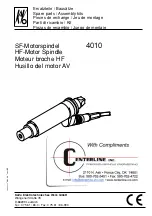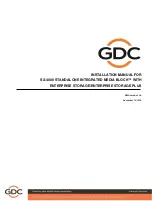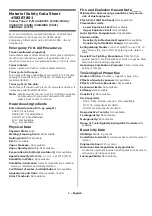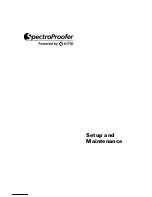
2-8
Rev 2.2, 10/31/94
sounded more natural when the accentuation of sibilants ("s" sounds) was reduced. By sensing
and limiting certain frequencies, the de-esser is intended to provide more specific control over
some of the higher frequency vocal sounds that tend to become overemphasized.
Most sibilant vocal sounds like "s", "sh," and "t" are very difficult to reproduce electronically
because they contain a large percentage of very high frequency harmonics. Since these sounds
are so essential to the intelligibility of speech, they can't be simply removed with equalization.
In fact, to help maintain articulation, many sound engineers routinely boost the higher
frequencies of the vocal spectrum (3 kHz to 8 kHz), and/or use microphones with "presence
curves" (like the Neumann U-87 or AKG C-414). However certain individuals and even certain
languages contain overemphasized sibilants and any sort of high frequency boost only
exacerbates the problem.
2.6 Noise Reduction
Noise reduction is the process of removing the noise from a signal without (hopefully) affecting
the signal itself. There are two types of noise reduction: single ended (the 601), and double-
ended (like Dolby noise reduction
2
).
A double-ended system such as the Dolby System eliminates noise contributed between its
encode and decode processors. By necessity, this means that you must have access to the
signal before it has noise added to it, and afterwards. For tape recorders and their ilk, this is
perfect. Of course, if you feed a Dolby noise-reduced system a noisy signal, it will simply hand
it back to you, without any added noise of course, but with just as much noise as you gave it to
begin with (garbage in, garbage out or GIGO).
A single ended noise reduction system works on whatever signal you hand it. Single-ended
systems depend on noise masking by the signal. That is, when the signal is present, it tends to
mask the noise. So when the signal is quiet or absent, reduce the noise (by reducing the high-
frequency response), and when the signal is present, remove the high-frequency rolloff and
pray that the signal masks the noise.
If you're handed a noisy signal, then a single-ended noise reduction processor is your best
weapon against the noise. If you combine this with some careful equalization, you'll probably
end up with a signal that is more listenable.
2.7 Downward Expansion
Expansion is the process of increasing a signal's dynamic range, usually by increasing the
signal's level by a precise amount for every dB over a magic signal level (the "threshold").
Unfortunately, this requires infinite (or at least
near
infinite) headroom.
A simple, but entirely satisfactory solution is to reduce the signal's level for every dB below a
magic signal level (the "threshold"). This is called
downward expansion
. A similar and related
device is the
signal gate
. You can think of a signal gate as a special case of a downward
expander (or vice-versa if you must). Both devices reduce their output when their input signal
falls below threshold. The difference is the rate (not speed) at which they do it. The 601’s
downward expander output falls at an adjustable rate for every 1 dB below threshold of the
input signal. A gate's output falls by a nearly infinite amount for the slightest change, below
threshold, of the input signal. You can think of a gate as a downward expander taken to the
extreme, or you can think of a downward expander as a subtle example of a gate.
Gates are generally used to remove leakage (unwanted signals from nearby sources) from a
signal. Downward expanders are used to remove extraneous noise and to increase dynamic
range by making the softer parts softer.
Compressors or limiters (for the purposes of this discussion, a limiter is simply a high-ratio
compressor) are often used to reduce dynamic range by setting an upper limit on larger signals.
2
Dolby is a trademark of Dolby Laboratories, San Francisco, CA, USA.
Summary of Contents for 601
Page 46: ...4 18 Rev 2 2 10 31 94 This page is blank believe it or not ...
Page 48: ...4 20 Rev 2 2 10 31 94 Notes ...
Page 50: ...5 2 Rev 2 2 10 31 94 Notes ...
Page 70: ...7 16 Rev 2 2 10 31 94 Notes ...
Page 72: ...8 2 Rev 2 2 10 31 94 Notes ...
Page 74: ...9 2 Rev 2 2 10 31 94 Notes ...
Page 78: ...11 2 Rev 2 2 10 31 94 Notes ...
Page 126: ...D 12 Rev 2 2 10 31 94 Notes ...
Page 138: ...G 8 Rev 2 2 10 31 94 Notes ...
















































